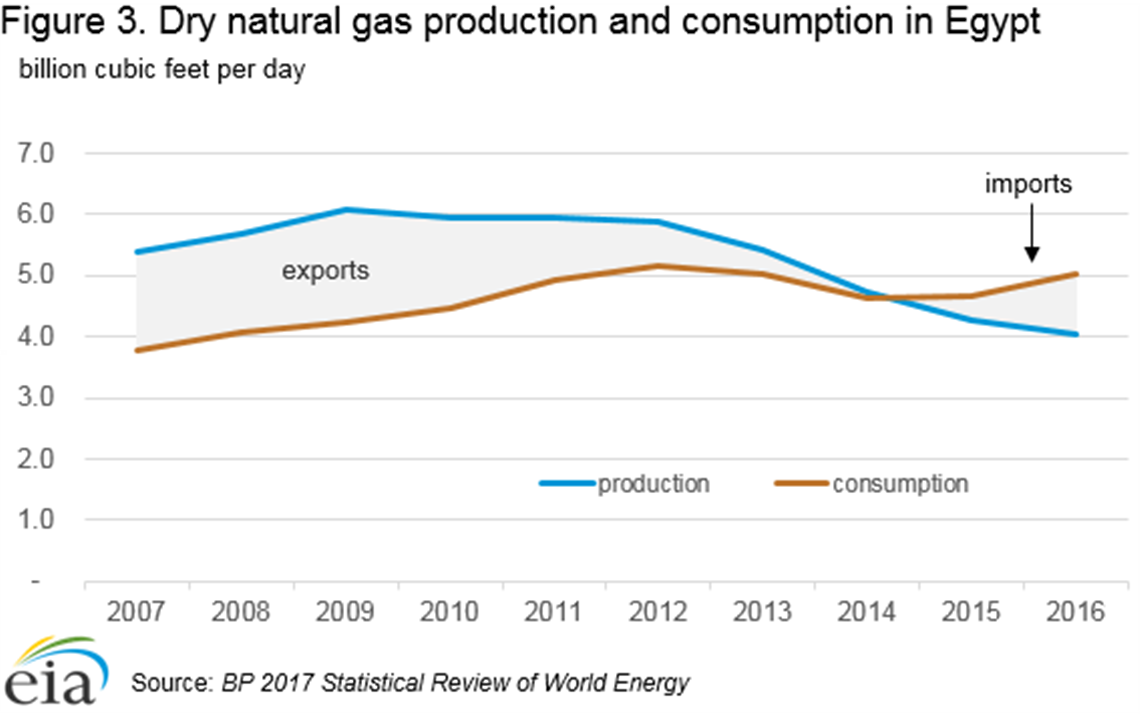Egypt Poised To Become Net Natural Gas Exporter Again
May 25, 2018

The latest report on Egypt from the U.S. Energy Information Administration (EIA) notes that although the country became a net importer of natural gas in 2015, substantial natural gas discoveries may potentially boost production and allow Egypt to become a net exporter again in the medium term.
Despite new discoveries, Egypt’s dry natural gas production declined by 31% from 2012 to 2016, leading to net imports since 2015. Egypt produced approximately 4.0 billion cubic feet per day (Bcf/d) of dry natural gas and imported 1.0 Bcf/d in 2016 (Figure 2). To satisfy growing domestic demand, Egypt has had to divert its natural gas supply away from exports to the domestic market and to rely on liquefied natural gas (LNG) imports to address the shortfall in consumption, according to the EIA report. Egypt acquired two floating storage and re-gasification units (FSRUs) in 2015; plans for a third FSRU were canceled in 2016 because of higher anticipated domestic production. Much of the natural gas consumed in Egypt is used to fuel electric power plants, and the Egyptian government encourages households, businesses, and the industrial sector to consider natural gas as a substitute for petroleum products and coal.
The Egyptian government has fast-tracked the development of the Zohr and Atoll fields and the West Nile Delta (WND) project. These fields are expected to make substantial additions to overall supply. Discovered in August 2015 and labeled as the largest offshore natural gas field in the Mediterranean, the Zohr gas field has an estimated reserve of 30 Tcf and is currently producing 0.4 Bcf/d.
Natural gas production began in 2017 and is expected to produce 1 Bcf/d after the first phase of the project is completed in 2018; peak plateau production is estimated at 2.7 Bcf/d and is expected to be reached by the end of 2019. Natural gas production at the Atoll field also began in February 2018 and is currently producing 0.35 Bcf/d of natural gas and 10,000 b/d of condensate. Production began seven months ahead of schedule and the field has an estimated 1.5 Tcf of natural gas and 31 million barrels of condensates, with other areas still under evaluation, according to the EIA. Developed as two separate projects to speed up development, the WND project started producing natural gas in March 2017 and is currently producing more than 0.7 Bcf/d and 1,000 b/d of condensate; the two projects are expected to be fully online in 2019 and to produce close to 1.5 Bcf/d, all of which is expected to feed into Egypt’s national electricity grid. BP is the main operator and holds an 82.75% stake. Although the government hopes the new discoveries coming online will allow the country to resume natural gas exports, imports will most likely still be needed to satisfy domestic demand, albeit at smaller volumes, the EIA noted.
The Suez Canal transit route also has liquefied natural gas (LNG) flows in both directions, accounting for a substantial amount of global LNG trade. Southbound LNG transit primarily originates in Nigeria, France (as re-exports), and Trinidad and Tobago, and most LNG is exported to Egypt, Jordan, and Japan. Nearly all northbound transit originates from Qatar and is exported to European markets.
Egypt has two LNG export facilities with a combined capacity of 586 Bcf per year. The Spanish-Egyptian Gas Company (SEGAS) LNG facility in Damietta is a single LNG train with a capacity of 240 Bcf per year and is owned by Union Fenosa Gas (80%) and by EGPC and EGAS (10% each). The SEGAS LNG facility began production in December 2004, but had operated below its nameplate capacity until the plant closed in December 2012 as a result of growing domestic energy demands.
Egypt’s other LNG facility, the Egyptian LNG project (ELNG), is located at Idku and is a joint venture that includes Shell, Petronas, EGAS, EGPC, and ENGIE. The facility has two LNG trains, each having a capacity of 172.8 Bcf per year. ELNG began production in May 2005, but the facility was idle from late 2014 to April 2016; it has since sporadic exports of LNG. In 2016, Egypt exported approximately 26 Bcf of LNG. Most of the exports went to the Asia-Pacific (61%) and the Middle East (24%), according to the 2017 BP Statistical Review of World Energy.
MAGAZINE
NEWSLETTER

CONNECT WITH THE TEAM






